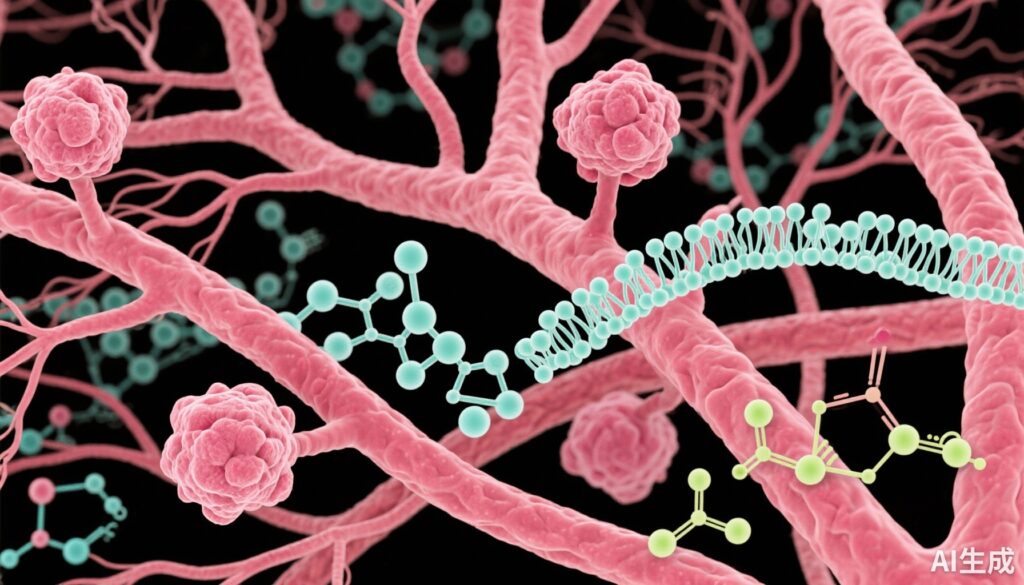Highlight
- LMW-DSS, a sulfated polysaccharide derived from dextran, acts as a potent heparanase (HPSE) inhibitor by mimicking heparan sulfate (HS).
- In vitro, LMW-DSS binds directly to HPSE, reducing its enzymatic activity and expression, leading to decreased migration, invasion, and epithelial-mesenchymal transition (EMT) in breast cancer cells.
- LMW-DSS suppresses angiogenesis by inhibiting human umbilical vein endothelial cell (HUVEC) formation and downregulating proangiogenic factors.
- In vivo, LMW-DSS effectively reduces pulmonary metastasis in a 4 T1-Luc mouse breast cancer model with a favorable safety profile and minimal bleeding risk.
Study Background and Disease Burden
Breast cancer remains a leading cause of cancer-related morbidity and mortality worldwide, with aggressive subtypes frequently marked by early invasion and metastasis. The metastatic spread, especially to the lungs and other vital organs, substantially worsens prognosis and limits therapeutic options. Current treatments targeting metastatic breast cancer face challenges including drug resistance and off-target effects.
Heparanase (HPSE), an endoglycosidase that degrades heparan sulfate proteoglycans in the extracellular matrix, facilitates tumor cell invasion and angiogenesis, two critical processes in metastasis. Elevated HPSE expression correlates with aggressive tumor phenotypes and poor clinical outcomes. Thus, HPSE represents a compelling therapeutic target to inhibit metastatic progression while potentially limiting angiogenesis-driven tumor growth.
Existing HPSE inhibitors have been limited by pharmacologic drawbacks such as inadequate potency or high bleeding risks. The development of novel inhibitors with strong efficacy and acceptable safety profiles is therefore an unmet medical need in breast cancer management.
Study Design
This preclinical study explored the anti-metastatic potential of low-molecular-weight dextran sulfate sodium (LMW-DSS), a semi-synthetic sulfated polysaccharide derived from dextran designed as a heparan sulfate mimic. The study combined in vitro mechanistic experiments with in vivo efficacy and safety evaluation in a murine breast cancer model.
– In vitro experiments utilized 4 T1 murine mammary carcinoma cells and human umbilical vein endothelial cells (HUVECs) to assess migration, invasion, epithelial-mesenchymal transition (EMT), and angiogenesis.
– Direct binding assays and enzymatic activity measurements characterized the interaction between LMW-DSS and HPSE.
– Proangiogenic factors were quantified to evaluate angiogenic modulation.
– The in vivo component employed a 4 T1-Luc (luciferase-tagged) metastatic mouse model, enabling real-time assessment of pulmonary metastasis and monitoring of treatment safety, including bleeding risks.
Key Findings
The investigation revealed several critical outcomes:
1. Direct HPSE Inhibition by LMW-DSS: LMW-DSS demonstrated direct binding affinity to HPSE, effectively inhibiting its enzymatic activity. This inhibition also triggered downregulation of HPSE expression in 4 T1 breast cancer cells, suggesting a dual mechanism of action.
2. Suppression of Cancer Cell Migration and Invasion: In vitro assays showed that HPSE inhibition by LMW-DSS significantly reduced the migratory and invasive capacities of 4 T1 cells. These effects coincided with decreased markers of epithelial-mesenchymal transition (EMT), a process central to metastatic capability, indicating reversal of pro-metastatic phenotypes.
3. Inhibition of Angiogenesis: LMW-DSS suppressed tube formation in HUVEC cultures, a model of angiogenesis. It also downregulated key proangiogenic factors, including VEGF, supporting the anti-angiogenic capacity of LMW-DSS.
4. In Vivo Anti-Metastatic Efficacy and Safety: When administered to 4 T1-Luc metastatic mice, LMW-DSS significantly reduced pulmonary metastases, as evidenced by bioluminescence imaging. Importantly, no significant bleeding events or toxicity were observed, highlighting a favorable safety profile.
Taken together, these findings underscore LMW-DSS as a potent inhibitor of HPSE with dual anti-metastatic and anti-angiogenic effects.
Expert Commentary
The introduction of LMW-DSS represents a notable advancement in the targeted inhibition of heparanase to combat breast cancer metastasis. By mimicking the natural substrate heparan sulfate, LMW-DSS achieves specific binding and inhibition of HPSE, a strategy that differentiates it from less specific agents. The dual impact on both tumor cell invasive behavior and tumor-supportive angiogenesis aligns well with current understandings of metastatic progression as a multifaceted process.
Compared to previous HPSE inhibitors, LMW-DSS’s minimal bleeding risk is a critical advantage, making it a more clinically viable candidate. This is particularly relevant given that many anticoagulant or polysaccharide therapeutics bear intrinsic risks of hemorrhage.
Limitations of the current study include reliance on a single animal model and the short-term nature of in vivo observation. Further studies in diverse preclinical models, including humanized systems, and eventual clinical trials are necessary to establish translational relevance and optimal dosing strategies.
Mechanistically, the observed downregulation of HPSE expression by LMW-DSS invites deeper exploration into regulatory feedback loops modulated by this agent. Understanding potential off-target effects and interaction with other components of the tumor microenvironment will be essential to optimize therapeutic efficacy.
Conclusion
LMW-DSS emerges as a promising heparanase inhibitor with substantial efficacy in suppressing breast cancer metastasis through inhibition of cell migration, invasion, EMT, and angiogenesis. Its novel mechanism as a heparan sulfate mimic confers potency and specificity, coupled with a favorable safety profile characterized by minimal bleeding risk.
This agent has significant potential to fill an unmet need in the treatment of aggressive breast malignancies by targeting critical pathways involved in dissemination and tumor neovascularization. Further research is warranted to advance LMW-DSS through preclinical development and into human clinical trials.
References
1. Mo Y, Song G, Fu L, Wang Y, Geng T, Sun A, Gou B, Meng X, Zhang L, Wang H, Li Z, Li Z. Low-molecular-weight dextran sulfate sodium as novel heparanase inhibitor preventing breast cancer metastasis in mice by inhibiting migration and angiogenesis. Carbohydr Polym. 2025 Dec 1;369:124255. doi: 10.1016/j.carbpol.2025.124255. Epub 2025 Aug 22. PMID: 40973280.
2. Vlodavsky I, et al. Heparanase: From basic research to therapeutic applications in cancer and inflammation. Drug Resist Updat. 2012;15(3):126-139.
3. Ramani VC, Sanderson RD. Heparanase and tumor microenvironment: Potential applications in cancer therapy. J Cell Biochem. 2014;115(9):1561-1570.
4. Dredge K, et al. Clinical development of a heparanase inhibitor, PI-88, in advanced malignancies. Oncology. 2011;79(3-4):196-202.
5. Yang Y, et al. Role of epithelial to mesenchymal transition in breast cancer metastasis: Friend or foe? Oncotarget. 2017;8(48):86301-86311.

